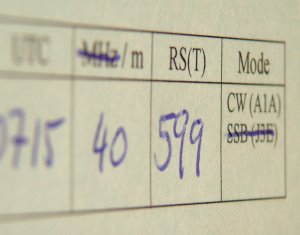
Reporting the quality of a radio communication is very important feedback information. There are two important types of reports: the "RST report" and the "SINPO report".

The RST report (Radio, Signal, Tone) [1, 2] is manly used by amateur radio operators and describes the quality of a radio communication with a two or three digit number.
The first digit describes the intelligibility of the signal, the second the strength of the signal and if it's a CW transmission, the third digit describes the quality of the tone.
The RST report is just a subjective evaluation of the received signal and it's not supposed to be a precise measure. In practice the majority of the reports are 59 (or 599) as a sort of courtesy to the corresponding ham, regardless of the quality of the QSO.
| Radio | Strength | Tone (CW only) |
|
1 Not intelligible. 2 Just intelligible: some words only. 3 Bad intelligibility. 4 Good intelligibility. 5 Very good intelligibility. |
1 Extremely low signals. 2 Very low signals. 3 Low signals. 4 Poor signals. 5 Medium signals. 6 Good signals. 7 Strong signals. 8 Very strong signals. 9 Extremely strong signals. |
1 Only noise. 2 Very noisy AC tone. 3 Low AC tone. 4 AC tone. 5 Modulated tone, whistle in the background. 6 Modulated tone, some noise. 7 DC tone, little noise. 8 Good DC tone, very little noise. 9 Pure DC tone. |
The SINPO report (Signal, Interference, Noise, Propagation, Overall) [3] is manly used by SWLs (Short-Wave Listners) and describes the quality of a radio communication with a five digit number. This same report is sometimes also called SNIFO (Signal, Interference, Noise, Fading, Overall).
This report is more accurate than the RST that is very often just 59 and therefore doesn't really reflect the quality of the received signal. SINPO reports are very appreciated by broadcast station for the quality of the feedback information.
In this report all digits are from 1 (worse) to 5 (best) according to the following table:
| Signal: strength of the received signal | Interference: interference from other stations | Noise: presence of atmospheric or other noise | Propagation: fading characteristics of the signal | Overall: how well the signal is received |
|
1 Barely audible 2 Poor 3 Fair 4 Good 5 Excellent |
1 Extreme 2 Severe 3 Moderate 4 Slight 5 None |
1 Extreme 2 Severe 3 Moderate 4 Slight 5 None |
1 Extreme 2 Severe 3 Moderate 4 Slight 5 None |
1 Barely audible 2 Poor 3 Fair 4 Good 5 Excellent |
The SIO report (Signal strength, Interference, Overall quality) is a simplified version of the SINPO report that is sometimes used, where the noise and propagation information is omitted.
| [1] | Nerio Neri I4NE. Radiotecnica per Radioamatori. C&C - Edizioni Radioelettroniche, 1994, Appendice 14. |
| [2] | Carlo Amorati I4ALU. Manuale di radiotelegrafia. C&C - Edizioni Radioelettroniche, 1995, p. 98. |
| [3] | R. Pavanello. Rapporti d'ascolto: tutti i segreti. Progetto-Elektor, N.3, Marzo 1995, pp. 12-15. |
| Home | Electronics | Index | Page hits: 037730 | Created: 10.1999 | Last update: 10.2013 |